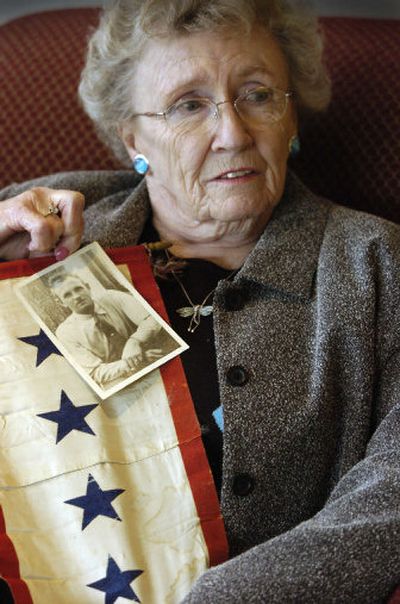Years later, loved ones find answers

They are never forgotten – years, decades, even half a century after they have disappeared.
Tears still flowed Saturday as families remembered their loved ones who fought in war and went missing in action.
Their voices cracked. Anguish filled their faces. Many never knew what happened to their fathers, brothers, uncles or sons who more or less vanished in combat.
Their remains never made it home.
“It still hurts, even now,” said Beatrice Hansen of Spokane, one of about 80 family members who gathered Saturday at the DoubleTree Hotel downtown for an all-day briefing organized by the Department of Defense’s POW/Missing Personnel Office.
Dozens of government specialists traveled to Spokane to provide personalized updates for families of American servicemen who remain missing in action. Family members not only learned about the efforts to find those unaccounted for after World War II, the Korean War, the Vietnam War and the Cold War; they also got a chance to provide DNA samples, meet one-on-one with specialists and learn about the latest technology to identify remains.
Hansen, 78, lost her oldest brother during World War II. Sgt. John Lynn Boomer of the U.S. Army Air Forces was 22 and a bombardier when his plane was lost on Nov. 23, 1942. All Hansen ever knew about his death she learned from the telegram that was delivered to their home – that Lynn, as he was called by friends and family, was part of a crew on a plane that was shot down by enemy fire somewhere over France.
“That was the best they could do in those days,” said Hansen, who was 15 years old at the time and living with her parents in Durand, Ill. She and her family didn’t know how many men were on the plane and what kind of aircraft it was, let alone if it crashed after the attack.
Hansen never cried. Deep inside, she believed that Boomer survived and that he would come home when the war was over. As time passed, she continued to wonder about her brother’s whereabouts and began to doubt if he was alive. Yet even as her expectations dimmed over the decades, a flicker of hope remained.
“I am the last surviving sibling,” said Hansen, the youngest of seven children. “I have high hopes that maybe before I’m gone, the military will call with his remains.”
Hansen and her husband, Robert, also a U.S. Army veteran, arrived early on Saturday, along with dozens of other families from throughout Eastern Washington and Idaho. In her arms she carried a folder with a black-and-white photograph of Boomer, copies of newspaper articles, and the red and white banner that her mother hung in the front window of their home. The banner bears four blue stars, each representing one child from the family who served in the military during World War II. Sgt. Lynn Boomer was the only one who didn’t make it home.
Family members like Hansen usually have to travel to Washington, D.C., to review their case files, but the POW/Missing Personnel Office also sends specialists once a month to communities throughout the country. While the briefings are designed for families to gather information, it’s also a chance for them to honor their loved ones, said Larry Greer, the office’s director of Public Affairs.
During their first visit to Spokane Saturday, government specialists provided information about 15 servicemen who went missing during the Vietnam War, 20 who were lost during the Korean War, seven from World War II and one from the Cold War.
After years of waiting, some families do indeed find answers. One of the cases Saturday involved the recent identification of the remains of First Lt. Alvin Crane, a U.S. Air Force pilot who was shot down in North Korea in 1951. Family members, including Arthur Crane of Spokane, spent decades looking for information. They knew Alvin Crane was leading a squadron of bombers when he was hit. His plane crashed, but witnesses saw a parachute in the air and later someone on the ground putting a parachute away. He might have ended up becoming a prisoner of war, they thought.
In 1990, the North Koreans returned five sets of remains to the United States. About a month ago, thanks to DNA testing, one of those sets was positively identified as Alvin Crane. Next spring, Arthur Crane will travel to Hawaii to retrieve his brother’s remains and bury them in Santa Rosa, Calif., near his parents’ graves on May 13 – his mother’s birthday. When she died a year and a half ago at the age of 94, Lois Crane still hadn’t stopped hoping that her son was still alive.
On Saturday, more good news arrived for some families, including Hansen, who was almost in tears as she discovered information about her brother.
Sgt. John Lynn Boomer, a member of the 324th Bombardment Squadron, was lost when his B-17F bomber failed to return from a bombing mission to St. Nazaire, France, according to the report. The group of four bombers encountered a flight of 16 enemy FW-190 fighters that pursued them as they headed back to England. The U.S. planes were able to destroy some of the enemy aircrafts, but the lead plane carrying Boomer and 10 others suffered two damaged engines and disappeared into heavy clouds.
No one saw a crash, according to the reports based on documents and eyewitness interviews. The plane may have fallen into the English Channel or been forced to land on the Brest Peninsula. A memorial in a Cambridge cemetery bears his name, along with others who were missing in action that day.
“I was just happy to finally have some answers,” Hansen said. “This is so much more than I had known in the last 63 years.”